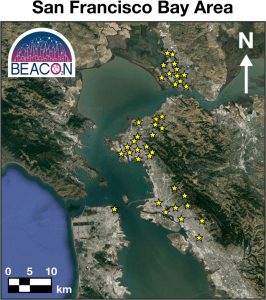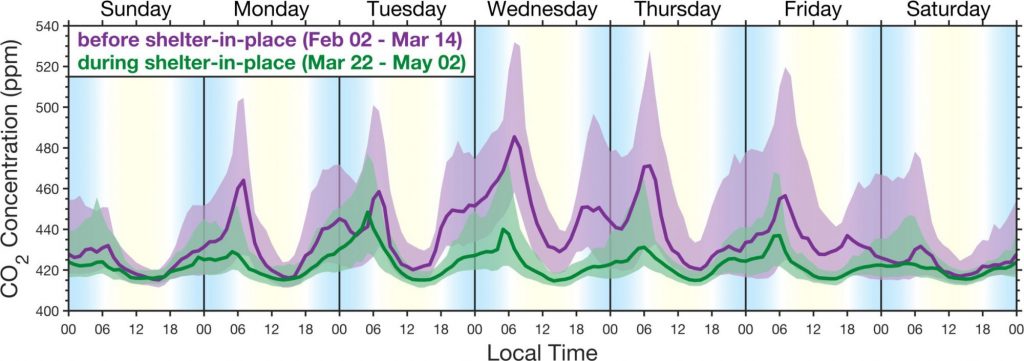How did COVID-19 affect our carbon emissions?
Key Points & Overview
- We observe a 30% decrease in urban CO2 emissions in response to COVID-19 mobility restrictions.
- Changes are primarily driven by changes in traffic (-48%) with minimal changes to stationary CO2 sources (-8%).
- These findings provide a glimpse into a future with reduced CO2 emissions through the electrification of vehicles.

The abrupt shuttering of the economy in response to the COVID-19 global pandemic led to widescale speculation in both the scientific community and broader public about how our carbon emissions would change (e.g., “The Coronavirus and Carbon Emissions” from the New York Times). All of the early estimates were based on projections from models that predict carbon emissions using economic data. In other words, they did not incorporate measurements of CO2 in the atmosphere. As such, it was unclear if the atmospheric measurements would find similar changes or not. Our paper, published in October 2020 in Geophysical Research Letters, was the first paper to quantify the changes in carbon emissions using atmospheric measurements.
We used a dense network of sensors across the San Francisco Bay Area (yellow stars in Image 1) to quantify the impacts of COVID-19 on our carbon emissions using measurements of CO2 in the atmosphere. The observed changes in CO2 concentration were quite striking (Image 2). We observed a pronounced change to both the daily and weekly cycle of CO2. Before the lockdown the highest concentrations were typically during the middle of the week near the morning rush hour, this signal was largely absent after the lockdowns were implemented. Instead, the weekdays and weekends showed a nearly identical daily cycle after the lockdowns. These observations suggested large reductions in CO2 emissions. However, quantifying and attributing the changes to emissions requires accounting for changes in both weather patterns and vegetation (plants take up carbon during photosynthesis). To isolate the impacts of changes in emissions, we used a weather model and satellite observations related to photosynthesis. After accounting for variations in weather and plant activity, we found that urban CO2 emissions decreased by 30% in response to COVID-19. The bulk of these changes were due to traffic (-48%) with only an 8% decrease in stationary CO2 sources.

This unnatural experiment conducted in response to COVID-19 has highlighted the subset of carbon emissions that are elastic and those that are more entrenched. Emissions from traffic are highly elastic and could be rapidly mitigated in response to either technological advances or regulations. In contrast, the stationary emissions (e.g., industrial sources) showed minimal changes in response to COVID-19. These sources will require longer time scales and focused regulation to mitigate if we hope to limit future warming. Ultimately, our work helps to quantify what our future carbon emissions might look like if we were to electrify the vehicle fleet.